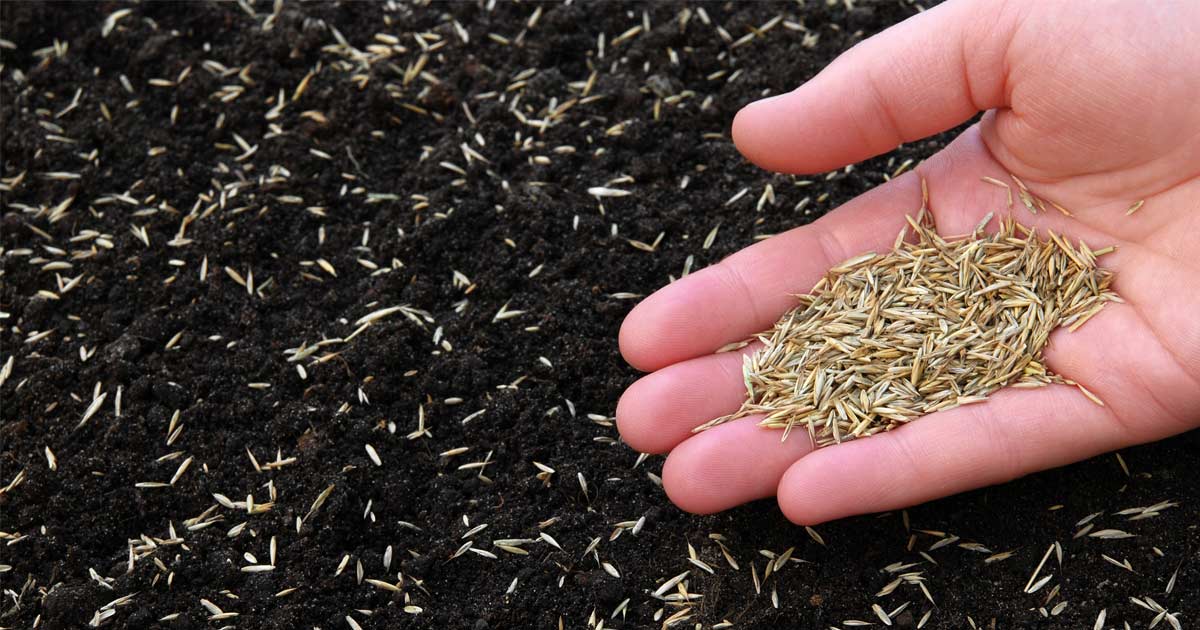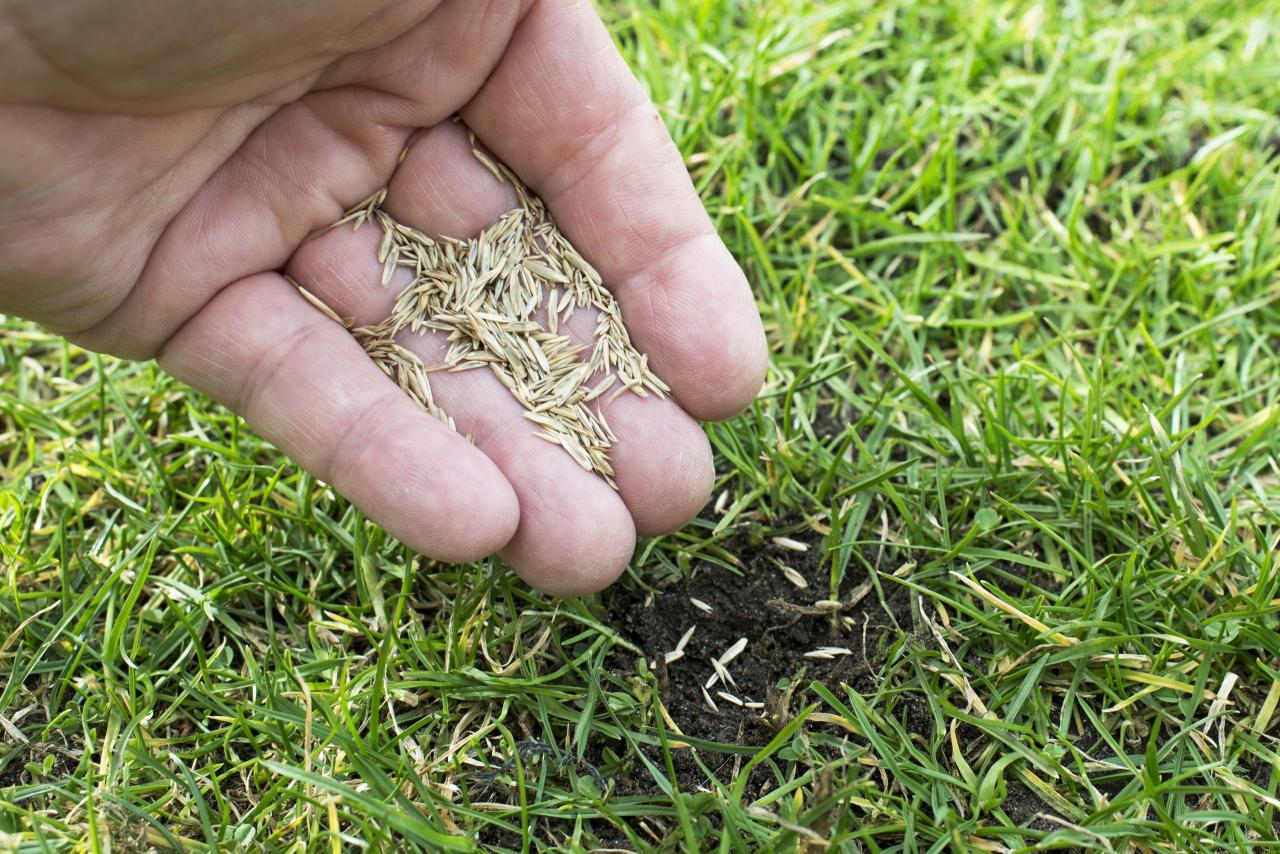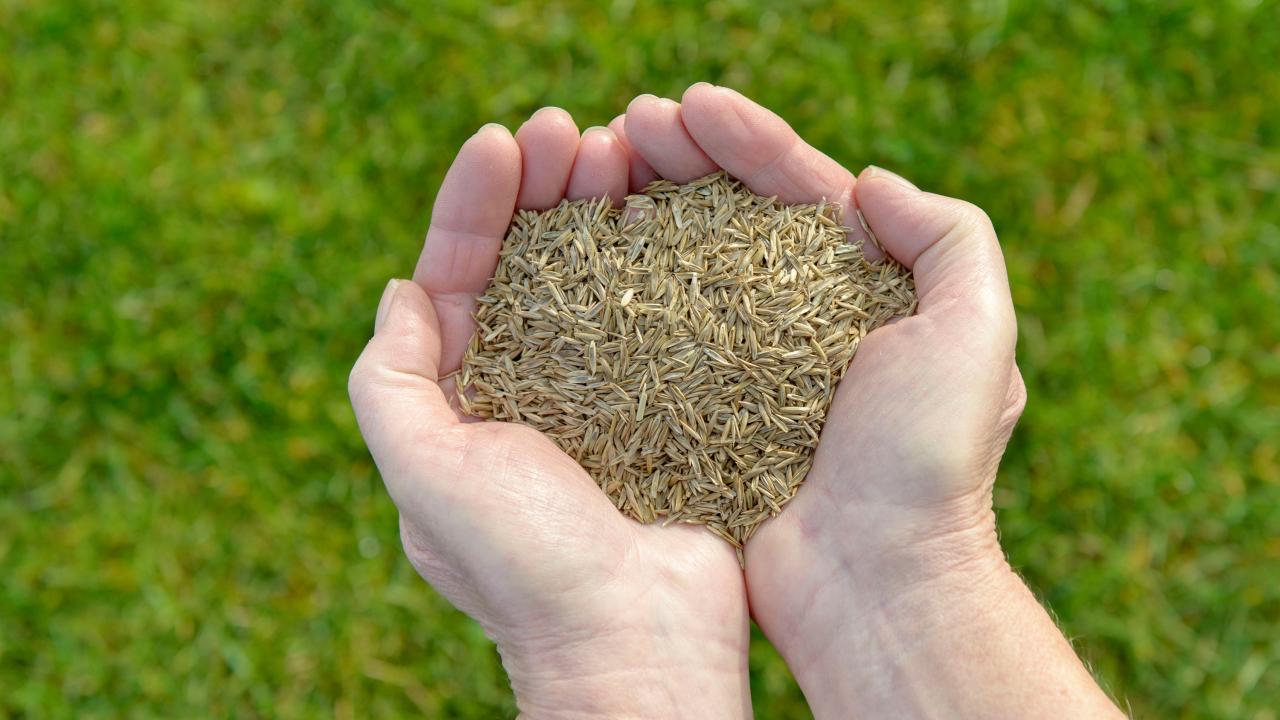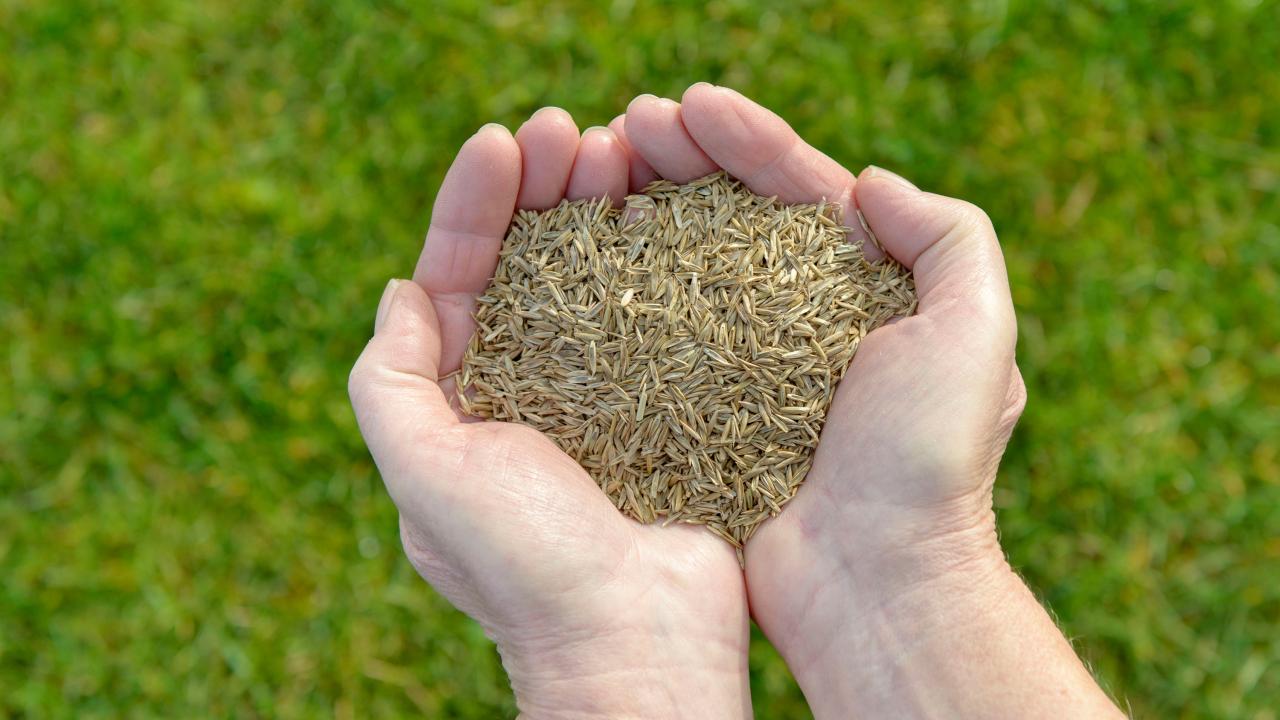Timing Your Grass Seed Sowing: Essential Tips for a Beautiful Lawn takes center stage, and this opening passage beckons readers into a world crafted with good knowledge, ensuring a reading experience that is both absorbing and distinctly original. A lush, green lawn is the dream of many homeowners, but achieving this goal requires more than just throwing down some grass seed and hoping for the best.
The key to a thriving lawn lies in understanding the critical role of timing in the grass seed sowing process. From the ideal sowing windows to the importance of soil preparation and post-sowing care, this comprehensive guide will equip you with the essential tips and techniques for a beautiful, healthy lawn.
This guide will delve into the importance of timing for successful grass seed sowing, exploring the impact of temperature, soil moisture, and light on seed germination and growth. We’ll then move on to identifying the optimal seasons for sowing grass seed in different climates, providing a detailed table outlining the best sowing windows for various regions.
Furthermore, we’ll discuss the critical role of soil preparation, covering soil testing, amending, and a step-by-step guide for preparing the soil for sowing. The guide will also cover the importance of choosing the right grass seed varieties for your climate and desired lawn type, comparing and contrasting different types based on their characteristics.
We’ll then explore different sowing techniques, including broadcasting, overseeding, and more, along with tips for achieving even seed distribution and coverage. Finally, we’ll cover post-sowing care, including watering, fertilizing, and managing pests and diseases, and provide solutions for troubleshooting common problems encountered during grass seed sowing.
Understanding the Importance of Timing
Timing is crucial for successful grass seed sowing. The success of your lawn depends on planting your seeds at the right time. This ensures optimal germination and growth, resulting in a lush, healthy lawn. Several factors influence the ideal timing for sowing grass seed, including temperature, soil moisture, and light.
Impact of Temperature
Temperature plays a crucial role in grass seed germination and growth. Each grass species has an optimal temperature range for germination. For example, cool-season grasses like Kentucky bluegrass and fescue germinate best in cooler temperatures between 60°F and 75°F (15°C to 24°C).
Warm-season grasses like Bermuda grass and zoysia grass germinate best in warmer temperatures between 75°F and 90°F (24°C to 32°C).When temperatures are too low, seed germination slows down or stops. Conversely, when temperatures are too high, seeds can become damaged or die.
It is essential to choose the right grass species for your climate and sow the seeds during the optimal temperature range for that species.
Ideal Timing for Grass Seed Sowing

Timing is crucial for successful grass seed germination and establishment. Understanding the ideal sowing windows for your region is essential for maximizing your chances of a lush, healthy lawn.
Optimal Sowing Windows for Different Climates
The best time to sow grass seed varies depending on your climate and specific growing conditions. Generally, there are two primary sowing windows: spring and fall.
Region |
Spring Sowing Window |
Fall Sowing Window |
Notes |
|---|---|---|---|
Northern Climates (USDA Zones 3-6) |
Late April to early June |
Late August to early October |
Avoid sowing in extreme heat or cold. |
Southern Climates (USDA Zones 7-10) |
Late February to early May |
Mid-September to early November |
Avoid sowing during the hottest months. |
Transitional Climates (USDA Zones 6-7) |
Late March to early May |
Mid-August to early October |
Adjust sowing times based on specific microclimates. |
Adjusting Sowing Times for Microclimates, Timing Your Grass Seed Sowing: Essential Tips for a Beautiful Lawn
Microclimates can significantly impact the ideal sowing times within a region. Consider these factors when adjusting your sowing schedule:
- Elevation:Higher elevations experience cooler temperatures and shorter growing seasons, so sowing times may need to be adjusted accordingly.
- Shade:Areas with significant shade will have cooler temperatures and slower soil warming, requiring a later sowing time in spring.
- Soil Drainage:Well-drained soils warm up faster than poorly drained soils, allowing for earlier spring sowing.
- Rainfall:Consistent rainfall is crucial for seed germination and establishment. Avoid sowing during periods of drought or excessive rainfall.
Preparing the Soil for Sowing
A well-prepared soil is crucial for successful grass seed establishment. It provides a foundation for healthy root development, ensures proper drainage, and promotes uniform germination.
Before sowing grass seed, it is important to assess the soil’s condition and prepare it accordingly. Soil testing can help determine the pH level, nutrient content, and other factors that may affect grass growth.
Soil pH Testing and Amendment
Soil pH refers to its acidity or alkalinity, measured on a scale of 0 to 14, with 7 being neutral. Most grasses thrive in slightly acidic soil with a pH between 6.0 and 6.5. If your soil pH is too high or too low, it can hinder grass growth.
You can purchase soil testing kits from garden centers or online retailers. Follow the instructions provided with the kit to collect and analyze a soil sample.
If your soil pH is too acidic, you can amend it with lime. If it is too alkaline, you can amend it with sulfur. The amount of amendment needed will depend on the soil’s current pH and the desired target pH.
Consult with a local garden center or extension office for specific recommendations on soil amendments for your area.
Preparing the Soil for Sowing
Once you have tested and amended your soil, you can begin preparing it for sowing. Follow these steps to ensure optimal conditions for grass seed germination:
- Remove existing vegetation:Clear the area of any existing grass, weeds, or debris. This can be done manually by hand-pulling or using a tiller or sod cutter.
- Loosen the soil:Use a garden fork or tiller to loosen the top 4-6 inches of soil. This allows for better root penetration and drainage.
- Rake the soil:After loosening the soil, rake it smooth to create a level surface. This helps ensure even seed distribution and promotes uniform germination.
- Remove rocks and debris:Carefully remove any large rocks, sticks, or other debris that may hinder grass growth.
- Water the soil:Thoroughly water the soil to ensure it is moist. This will help the seed germinate and establish roots.
Choosing the Right Grass Seed
Selecting the right grass seed is crucial for establishing a healthy and beautiful lawn. The type of grass you choose should be suitable for your local climate, soil conditions, and desired lawn characteristics. Different grass types have unique growth habits, maintenance requirements, and aesthetic qualities.
Comparing Different Grass Seed Types
Understanding the characteristics of different grass seed types is essential for making an informed decision. The table below compares common grass types based on their key features:
Grass Type |
Characteristics |
Advantages |
Disadvantages |
|---|---|---|---|
Kentucky Bluegrass |
Cool-season grass, forms dense, dark green turf. Requires regular fertilization and watering. |
Excellent wear tolerance, good disease resistance, attractive appearance. |
Slow to establish, susceptible to drought stress, can be dormant in hot summers. |
Perennial Ryegrass |
Cool-season grass, grows quickly, provides fast coverage. Needs regular mowing and fertilization. |
Fast germination and growth, excellent for overseeding, good for traffic areas. |
Short lifespan, can be susceptible to disease, requires frequent mowing. |
Fine Fescue |
Cool-season grass, tolerates shade and drought, forms a fine-textured lawn. |
Low maintenance, drought tolerant, shade tolerant, excellent for low-traffic areas. |
Slow to establish, can be susceptible to disease, may not be as wear-tolerant as other grasses. |
Zoysia Grass |
Warm-season grass, forms a dense, deep green turf. Tolerates heat and drought. |
Excellent drought tolerance, low maintenance, good disease resistance. |
Slow to establish, may be dormant in cooler months, requires regular mowing. |
Bermuda Grass |
Warm-season grass, aggressive growth habit, forms a dense, dark green turf. |
Excellent wear tolerance, good disease resistance, fast recovery from damage. |
Can be invasive, requires regular mowing, may need to be overseeded in cooler months. |
Sowing Techniques: Timing Your Grass Seed Sowing: Essential Tips For A Beautiful Lawn

The method you choose for sowing grass seed can significantly impact the success of your lawn establishment. Each technique has its advantages and disadvantages, so selecting the right one for your situation is essential.
Methods for Sowing Grass Seed
There are several common methods for sowing grass seed, each with its own set of advantages and disadvantages.
- Broadcasting:Broadcasting is the simplest method, involving scattering seed evenly over the prepared soil. This method is ideal for large areas and requires minimal effort. However, it can be difficult to achieve even seed distribution, especially in windy conditions.
- Overseeding:Overseeding involves scattering seed over an existing lawn to thicken it or introduce new varieties.
This method is often used to fill in bare patches or to improve the density of a thin lawn. It’s crucial to use a quality overseeding mix and follow the manufacturer’s instructions for optimal results.
- Drilling:Drilling is a more precise method that involves using a specialized drill to sow seed at a specific depth.
Timing your grass seed sowing is crucial for success, much like understanding the right time to add a unique ingredient like kaffir lime leaf to your dish. Just as the Discover the Culinary Magic of Kaffir Lime Leaf: Tips for Delicious Cooking article emphasizes the importance of using the right ingredient at the right time, your lawn will thrive if you sow your seeds during the optimal season for your region.
This technique is ideal for establishing new lawns or overseeding large areas. Drilling ensures consistent seed depth, which can improve germination rates.
- Hand Sowing:Hand sowing is a slower but more controlled method that involves scattering seed by hand. This technique is best suited for small areas and allows for precise seed placement.
- Mechanical Sowing:Mechanical sowing utilizes specialized equipment, such as a seed spreader or a lawn aerator with a seed attachment, to sow seed quickly and efficiently. This method is ideal for large areas and can achieve a more consistent seed distribution than broadcasting.
Proper Techniques for Each Method
Here’s a breakdown of the proper techniques for each sowing method:
Broadcasting
To broadcast seed effectively, follow these steps:
- Divide the area into sections:This helps ensure even seed distribution.
- Start at the edge of the area:Walk slowly and evenly across the section, scattering seed as you go.
- Overlap each pass:This helps to avoid gaps in seed coverage.
- Use a seed spreader:A seed spreader can help to distribute seed more evenly, especially for large areas.
Overseeding
Overseeding requires a slightly different approach:
- Prepare the existing lawn:Mow the lawn short, remove thatch, and aerate the soil to allow seed to reach the soil surface.
- Choose the right seed:Select a seed mix that’s compatible with your existing lawn.
- Apply seed evenly:Use a seed spreader or broadcast seed by hand, ensuring even coverage.
- Water regularly:Keep the soil moist to promote germination and growth.
Drilling
Drilling requires specialized equipment and is best left to professionals for large areas. However, for smaller areas, you can use a hand-held drill:
- Adjust the drill depth:Set the drill depth according to the seed type and soil conditions.
- Drill holes in a grid pattern:Space holes evenly to ensure adequate seed distribution.
- Drop seed into the holes:Place a few seeds in each hole.
- Cover the holes:Lightly cover the holes with soil to protect the seeds.
Hand Sowing
Hand sowing is a simple but time-consuming method:
- Divide the area into sections:This helps to ensure even seed distribution.
- Walk slowly and evenly across the section:Scatter seed by hand, ensuring even coverage.
- Overlap each pass:This helps to avoid gaps in seed coverage.
Mechanical Sowing
Mechanical sowing is the most efficient method for large areas. The specific techniques will vary depending on the equipment used.
However, in general:
- Prepare the soil:Ensure the soil is properly tilled and leveled.
- Adjust the seed spreader settings:Set the spreader to the appropriate seed rate and distribution pattern.
- Pass over the area evenly:Move the spreader at a consistent speed to ensure even seed distribution.
Tips for Achieving Even Seed Distribution and Coverage
No matter which sowing method you choose, these tips can help you achieve even seed distribution and coverage:
- Use a seed spreader:Seed spreaders can help to distribute seed more evenly, especially for large areas.
- Divide the area into sections:This helps to ensure even seed distribution.
- Overlap each pass:This helps to avoid gaps in seed coverage.
- Walk slowly and evenly:This helps to ensure even seed distribution.
- Use a visual guide:A visual guide, such as a grid or a measuring tape, can help to ensure even seed distribution.
- Check for gaps:After sowing, carefully check for gaps in seed coverage and fill them in as needed.
Post-Sowing Care

After you’ve sown your grass seed, the real work begins: nurturing those tiny seedlings into a lush, healthy lawn. Proper post-sowing care is crucial for establishing a strong root system and promoting vigorous growth. This involves consistent watering, appropriate fertilization, and vigilant protection from pests and diseases.
Watering Newly Sown Grass
Water is essential for seed germination and the development of a healthy root system. Consistent moisture is key to ensuring that the seeds sprout and the new grass establishes itself.
- Frequency:Water deeply and frequently, aiming for a light, consistent moisture level in the top few inches of soil. This typically means watering 2-3 times per day during the establishment period, which can last several weeks.
- Depth:Water deeply enough to reach the root zone, but avoid overwatering. Overwatering can lead to fungal diseases and suffocate the roots.
- Timing:Water in the morning to allow the soil to dry somewhat during the day, reducing the risk of fungal diseases.
Fertilizing Newly Sown Grass
Fertilizer provides essential nutrients for healthy grass growth, but it’s crucial to use it judiciously during the establishment phase. Over-fertilizing can damage young seedlings and hinder their development.
- Wait for the first mowing:Don’t fertilize until the grass has reached a height of about 2-3 inches and you’ve mowed it for the first time.
- Use a starter fertilizer:Choose a starter fertilizer specifically formulated for new lawns. These fertilizers are typically high in phosphorus, which promotes root development.
- Follow the label instructions:Apply the fertilizer according to the manufacturer’s recommendations. Over-application can harm the grass.
Protecting Newly Sown Grass from Pests and Diseases
Young grass is particularly vulnerable to pests and diseases. Taking proactive steps to prevent and manage these issues can help ensure a healthy lawn.
- Identify potential problems:Keep a close eye on your lawn for signs of pests or diseases, such as yellowing, wilting, or patches of dead grass.
- Use organic pest control:Consider using organic pest control methods, such as beneficial insects or nematodes, to manage pests naturally.
- Choose disease-resistant grass varieties:When selecting your grass seed, opt for varieties that are known to be resistant to common lawn diseases.
Troubleshooting Common Problems
Even with careful planning and execution, you may encounter challenges during grass seed sowing. Identifying and addressing these issues promptly can help ensure a healthy and thriving lawn.
Just like timing is crucial for sowing grass seed, understanding the right conditions for propagation is key to success. For instance, if you’re looking to expand your ivy collection, check out this comprehensive guide on Give Your Ivy a New Life: Simple Propagation Steps You’ll Love which provides detailed instructions for successful propagation.
Back to your lawn, ensuring the soil is at the right temperature and moisture levels is just as important as selecting the right seed variety for a lush, healthy lawn.
Addressing Common Issues
It’s important to understand the reasons behind common problems and how to rectify them.
- Uneven Germination:This can occur due to inconsistent seed distribution or inadequate soil moisture.
- Solution:Ensure uniform seed spreading using a spreader or by hand. Water the area thoroughly and consistently, maintaining adequate moisture levels.
- Thin or Sparse Grass:This can result from insufficient seed density, poor soil conditions, or competition from weeds.
- Solution:Over-seed the thin areas with the appropriate grass seed type. Improve soil fertility by adding compost or fertilizer. Control weeds with pre-emergent herbicides or hand-pulling.
- Disease or Pests:Diseases and pests can damage seedlings and hinder lawn establishment.
- Solution:Identify the specific disease or pest and apply the appropriate treatment. Fungicides can control diseases, while insecticides can manage pests. Consult a local gardening expert or agricultural extension office for recommendations.
- Poor Seedling Emergence:This can occur due to compacted soil, insufficient sunlight, or excessive thatch.
- Solution:Aerate the soil to improve drainage and root growth. Ensure adequate sunlight by removing any obstructions. Dethatch the lawn if necessary to allow seedlings to emerge.
Preventing Future Problems
Taking preventative measures can significantly reduce the likelihood of encountering issues during grass seed sowing.
- Soil Testing:Conduct a soil test to determine nutrient levels and pH. Adjust accordingly with amendments or fertilizers.
- Proper Seed Selection:Choose grass seed types suitable for your climate and soil conditions.
- Weed Control:Apply pre-emergent herbicides before sowing to prevent weed competition.
- Consistent Watering:Maintain consistent moisture levels throughout the germination and establishment period.
- Regular Maintenance:Mow regularly at the appropriate height and fertilize as needed to promote healthy lawn growth.
Final Summary
By following these essential tips, you’ll be well on your way to achieving a beautiful, healthy lawn that will be the envy of your neighborhood. Remember, timing is crucial for successful grass seed sowing, and understanding the nuances of this process will give you the edge in creating a thriving green space that you can enjoy for years to come.
Clarifying Questions
What is the best time to sow grass seed in my region?
The best time to sow grass seed varies depending on your region’s climate. Consult the table provided in the guide for specific sowing windows for your area.
How often should I water my newly sown grass?
Newly sown grass needs frequent watering, especially during the establishment period. Water deeply and consistently, aiming for 1-2 inches of water per week.
What type of fertilizer should I use for my new lawn?
Use a starter fertilizer specifically designed for new lawns. This type of fertilizer contains a higher proportion of phosphorus, which promotes root development.
What are some common problems I might encounter with my new lawn?
Common problems include poor germination, weeds, pests, and diseases. The guide provides solutions for addressing these issues.
